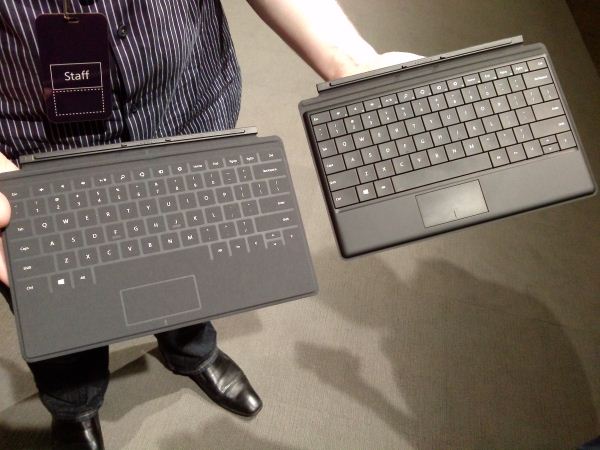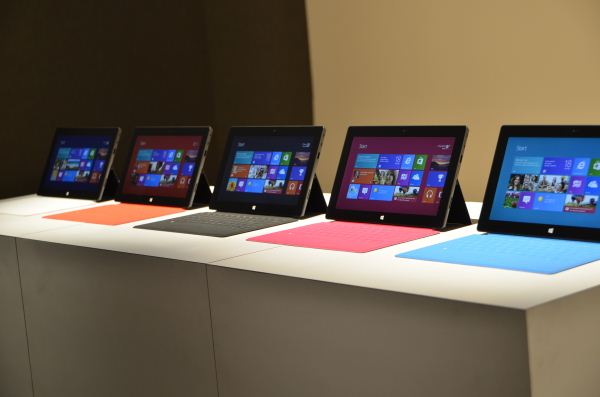Microsoft Surface - We Go Hands On [UPDATE: Detailed Impressions]
by Vivek Gowri on June 18, 2012 11:32 PM ESTPost-announcement, Microsoft took us to a backroom in Milk Studios to give us hands on experience with the Surface. They weren't lying, even the preproduction units feel awesome in hand. The magnesium panels are finished with partial vapour deposition, a process that deposits a thin-film coating onto the panel using vacuum deposition (molecule-by-molecule deposits at sub-atmospheric pressure.) It gives the unit a distinctly premium feel, and one that's pretty different from most of the other metal-bodied systems out there particularly with the current trends towards anodization and brushed finishes. The body is 9.3mm thick (a tenth of a millimeter thinner than the latest iPad), and total weight comes in at 676g (or about 1.49 lbs), so it's denser feeling than the iPad.. The 31.5Wh battery isn't as large as the iPad's 42.5Wh, but the 1366x768 10.6" LCD definitely draws less power.
The hinges in the kickstand are spring-loaded, giving a very positive mechanical feel and noise. The hinge mechanism is particularly robust, and as mentioned in the keynote, was acoustically tuned to sound high quality. Microsoft seemed particularly OCD about certain design details, this being one of them. It paid off though, with a hinge that looks and feels ready to take a lot of abuse. The stand props the system up at 22 degrees, which is a common theme - the beveled edges are all angled at 22 degrees, and the rear camera is also angled at 22 degrees in the opposite direction. This is a pretty interesting one, since it means you can keep the tablet angled as is usually comfortable, and still shoot video straight ahead. It's a good idea, though probably one that will take a bit of adjustment in real life use.
My personal favourite part of the Surface is the cover. There's two of them - the Touch Cover, and the Type Cover, both with integrated keyboards and touchpads. The Type Cover has a traditional keyboard, albeit one with particularly shallow feel, along with physically clicking mouse buttons. The Touch Cover is very interesting - it has a pressure sensitive membrane keyboard with felt keys and mouse buttons housed in a cover that's totally 3mm thick. (The Type Cover is ~5.5mm thick). I wasn't able to get a feel for how typing actually feels on it, so I can't comment on responsiveness or accuracy, but our friend Ben Reed at Microsoft Hardware swears he can top 50 words per minute on it any given day. I'm inclined to believe him, but I can't comment firsthand until I can actually play with a working unit.
The outside of the covers is covered in a felt material, and when closed, the unit feels like one of the velour or felt-covered journals. It gives a decidedly organic, natural feel to a very inorganic device, something that Microsoft was very pleased to note. It's a pretty awesome idea, actually, taking the best parts of Apple's Smart Cover and ASUS' laptop dock and merging them together into one of the most innovative cases we've seen. I took away three major things from this event, and the only one them that directly related to the device hardware being shown off was that integrating the keyboard into the cover was a stroke of awesome. (I'll go more in depth on the others in a larger post later today.)
For the first time, I can really see a tablet replacing a notebook as my primary computing device. Before today, I couldn't say that with any real conviction - I tried it with the iPad on multiple occasions, and it just didn't work. I'm a writer, tablets aren't ideal for writing. Surface changes that in a big way. And that's really what Microsoft is going for here - a device that fits into your life as a versatile tool to do anything you want it to. Whether they'll succeed in capturing the market is a story that will be told after Surface launches alongside Windows 8 later this year, but for now, this is a very promising start.




















161 Comments
View All Comments
solipsism - Tuesday, June 19, 2012 - link
That's simply not feasible.You're suggesting Apple would sell 1/3rd of the world's PCs. They already make more than 1/3rd of the world's profits in the PC market with about 7% going 4x as high would just be staggering considering how they market their machines.
There are market segments where they might be able to do that but the majority of the world's PCs are not sold at $999 and above. They are cheap HW running Windows.
As long as Apple prefers not to license their OS or go for unit market share over profit market share it's simply not going to happen.
Belard - Tuesday, June 19, 2012 - link
As of today: Mac OSX has 6.5% of the PC global market.XP = 44%
Win7 = 40%
Vista = 6.8% (HA HAH!)
Linux - 1% (Any day now... I can feel it)
In some countries, Mac sales would be higher... such as the USA and many European countries.
The USA market of iOS is larger than the global avg. (66%) vs Android.
I would love for Apple to sell a "non supported" - AS-IS with your hardware (but cannot sell with a Desktop) for $50~100. I'd buy that, put it on my desktop and be done with Windows. I like building my stuff.
But yes, Apple can make enough computers... the same Foxconn that makes desktops and notebooks for other companies will just change their Assembly lines component (the case) - not hard.
It would mean that Windows becomes the AMD (low-end) product line. Look back in the old days when intel sold their CPUs for 2-4x the price of AMD and yet had 80~90% of CPU sales with $300~800 CPUs.
silverblue - Wednesday, June 20, 2012 - link
If Microsoft position this thing below Ultrabook prices then they're going to headbutt AMD... especially considering IB wouldn't ordinarily find itself in this sort of market. I find it quite strange that Microsoft didn't opt for Trinity models although we don't really know yet how it would perform as compared to 17W IB ULV... could be any reason, really.Belard - Tuesday, June 19, 2012 - link
Your analogy is correct.Gates is wrong sometimes, but I doubt he'd have made the mistakes that we've seen in the past few years.
Ballmer can GO GO GO!
I don't see Microsoft rebounding... Unless you need 100% MS Office compatibility, whole the hell needs Windows?
mcnabney - Tuesday, June 19, 2012 - link
Gates is the retard that killed Courier.His reasoning? It didn't have an email application built-in.
andrewaggb - Tuesday, June 19, 2012 - link
Isn't that one of the reasons the playbook failed? :-pdagamer34 - Tuesday, June 19, 2012 - link
If systems were sold on specs, then the Transformer Prime should have outsold the iPad 2. It didn't. Heck, the Kindle Fire outsold the Prime!I care more about having a cohesive experience than specs. The ability to get content onto an iPad or Kindle Fire is why most Android tablets have failed in the market.
Belard - Tuesday, June 19, 2012 - link
true, for the most part. But even to this day. The iPad2 is the fastest gaming tablet. Asus doesn't have the public muscle of Apple... Imagine if HP sold the Transformer Prime? Remember HP is #2 seller of tablets... :)Fire is in a different demographic than the Transformer Prime.
Its like comparing a Ford Focus to a Mustang GT.
Belard - Tuesday, June 19, 2012 - link
That is what I mean... like the WP7 phones that come out with out-dated tech.I'm in the market for a new phone... but my Carrier only has the stupid huge Lumia 900... (Why not the 800 too?).. but all of them are single core (no big deal) and 2009~2010 screen resolution.
Also, WP8 doesn't make any advances in the metro interface that I get from my Android's WP7 Launcher... like custom colored individual titles and tile rotation.
So with that, looks like I'll get another Android phone and run my WP7/8 emulation... If I can run a WP7/8 emulation on an iPhone...
Dekker - Tuesday, June 19, 2012 - link
I have a sinking feeling that Microsoft will succeed in incorporating all of Windows' complexity into a tablet, rather than take the minimalistic mini-App route that the iPad has taken.There are a few things that concern me:
- the 16:9 screen ratio is not easily put to good use on a tablet
- with the stand and keyboard, the tablet looks like an Ultrabook without hinges. I prefer to have my Ultrabooks hinged and my tablets truly handholdable
- having two different flavours seems a mistake because it splits the Microsoft ecosystem in two
- no 16Gb version? hopefully that does not mean that windows 8 is a memory hog
- ecosystem conflicts because Microsoft will be competiting with hardware manufacturers
However, the design decisions make perfect sense if you believe that Windows compatibility is a killer feature in a tablet. We will soon find out whether it is.